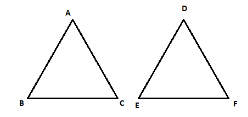
Write properties of congruent segments.
Answer
562.2k+ views
Hint: According to asked in the question we have to write the properties of congruent segment so, as we know that there are three properties of congruence for a given shape that can be line, triangle, square, parabola, and circle e.t.c first is the symmetric property of congruence which is explained below:
Symmetric property: In this property of congruence we will check the shape of the given figure that can be line, triangle, square, parabola, and circle e.t.c.
Now, the next one is transitive property of congruence which is explained below:
Transitive property: In this property of congruence we will check if the given figure is equal to another figure or not.
Now, the last property is the reflexive property of congruence and these properties can be applied to line segment, angle, triangles and the other given shape.
Complete step-by-step answer:
Step 1: First of all we will understand the symmetric property of congruence.
Symmetric property: For this property first of all we have to take a figure which is a triangle and as we know that the meaning of symmetric properties is that is a figure is equal or congruent to the other given figure which we take as a triangle.
So, let’s consider triangles ABC and DEF for the symmetric property.
Example:

So, if $AB \cong DE$ then, $DE \cong AB$
And if, $\angle A \cong \angle D$ then, $\angle D \cong \angle A$
Step 2: Now, we will understand about the transitive property of congruence,
Transitive property: First of all we have to understand the meaning of the transitive property which is if a figure can be line, triangle, square, parabola, and circle e.t.c is equal or congruent to another figure can be line, triangle, square, parabola, and circle e.t.c and this figure is also congruent or equal to another figure is known as transitive property of congruent.
Example:

If $AC \cong DF$ and $DF \cong GI$ then, $AC \cong GI$
If $\angle A \cong \angle D$ and $\angle D \cong \angle G$ then, $\angle A \cong \angle G$
Step 3: Now, we will understand about the reflexive property of congruence,
Reflexive property: $\Delta ABC \cong \Delta ABC$ means a triangle is always congruent or equal to itself.
Hence, asked in the question we have learned about all the properties of congruent segments which are symmetric, transitive and reflexive.
Note: All that there three properties of congruence can be applied for a given shape that can be line, triangle, square, parabola, and circle e.t.c
All these properties can be applied to line segments, angle, triangles and the other given shape.
Symmetric property: In this property of congruence we will check the shape of the given figure that can be line, triangle, square, parabola, and circle e.t.c.
Now, the next one is transitive property of congruence which is explained below:
Transitive property: In this property of congruence we will check if the given figure is equal to another figure or not.
Now, the last property is the reflexive property of congruence and these properties can be applied to line segment, angle, triangles and the other given shape.
Complete step-by-step answer:
Step 1: First of all we will understand the symmetric property of congruence.
Symmetric property: For this property first of all we have to take a figure which is a triangle and as we know that the meaning of symmetric properties is that is a figure is equal or congruent to the other given figure which we take as a triangle.
So, let’s consider triangles ABC and DEF for the symmetric property.
Example:

So, if $AB \cong DE$ then, $DE \cong AB$
And if, $\angle A \cong \angle D$ then, $\angle D \cong \angle A$
Step 2: Now, we will understand about the transitive property of congruence,
Transitive property: First of all we have to understand the meaning of the transitive property which is if a figure can be line, triangle, square, parabola, and circle e.t.c is equal or congruent to another figure can be line, triangle, square, parabola, and circle e.t.c and this figure is also congruent or equal to another figure is known as transitive property of congruent.
Example:

If $AC \cong DF$ and $DF \cong GI$ then, $AC \cong GI$
If $\angle A \cong \angle D$ and $\angle D \cong \angle G$ then, $\angle A \cong \angle G$
Step 3: Now, we will understand about the reflexive property of congruence,
Reflexive property: $\Delta ABC \cong \Delta ABC$ means a triangle is always congruent or equal to itself.
Hence, asked in the question we have learned about all the properties of congruent segments which are symmetric, transitive and reflexive.
Note: All that there three properties of congruence can be applied for a given shape that can be line, triangle, square, parabola, and circle e.t.c
All these properties can be applied to line segments, angle, triangles and the other given shape.
Recently Updated Pages
Master Class 9 Social Science: Engaging Questions & Answers for Success

Master Class 9 Science: Engaging Questions & Answers for Success

Master Class 9 English: Engaging Questions & Answers for Success

Master Class 9 Maths: Engaging Questions & Answers for Success

Master Class 9 General Knowledge: Engaging Questions & Answers for Success

Class 9 Question and Answer - Your Ultimate Solutions Guide

Trending doubts
Which places in India experience sunrise first and class 9 social science CBSE

Fill the blanks with the suitable prepositions 1 The class 9 english CBSE

Write the 6 fundamental rights of India and explain in detail

Difference Between Plant Cell and Animal Cell

What is pollution? How many types of pollution? Define it

What is the Full Form of ISI and RAW




